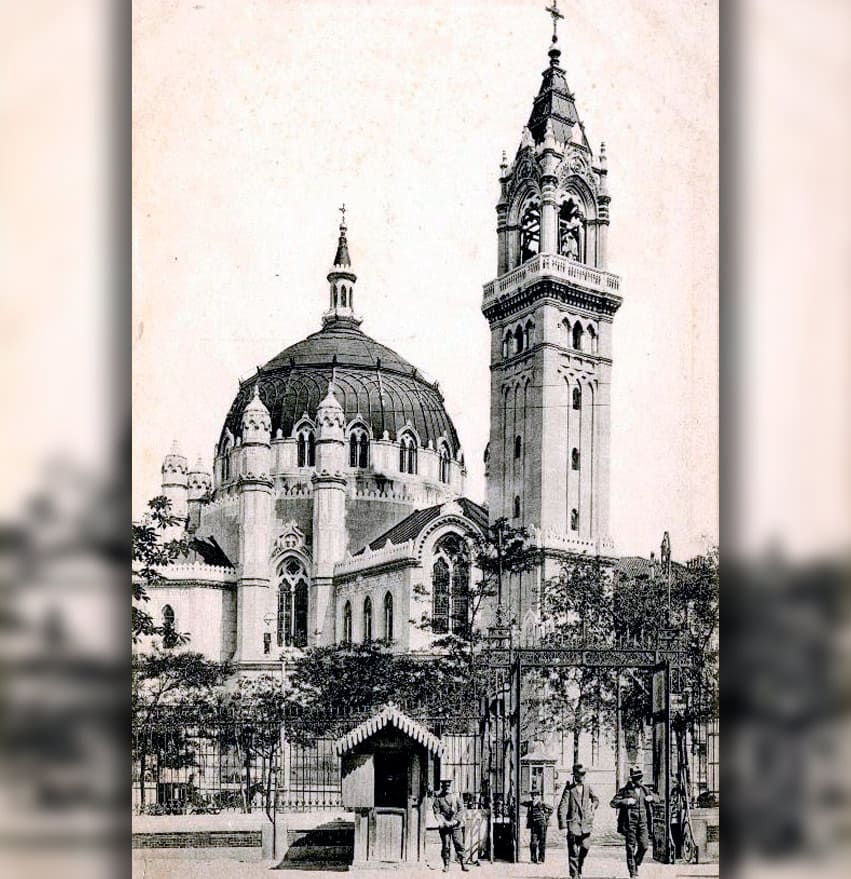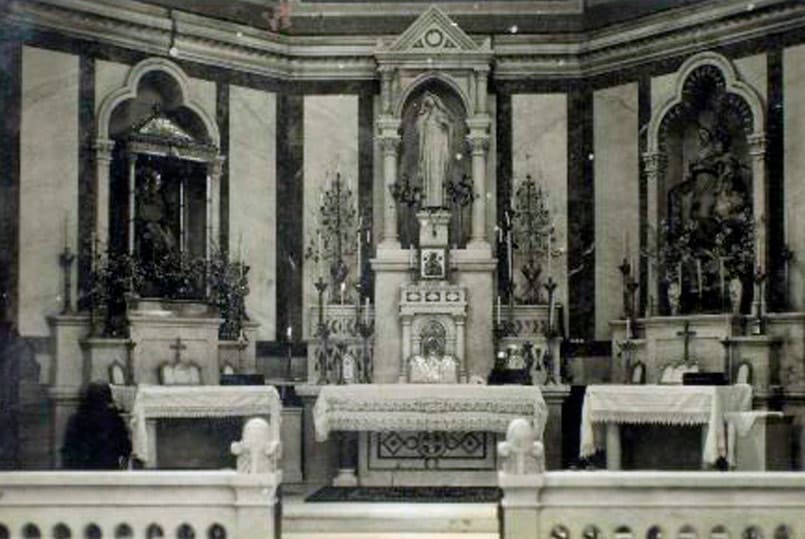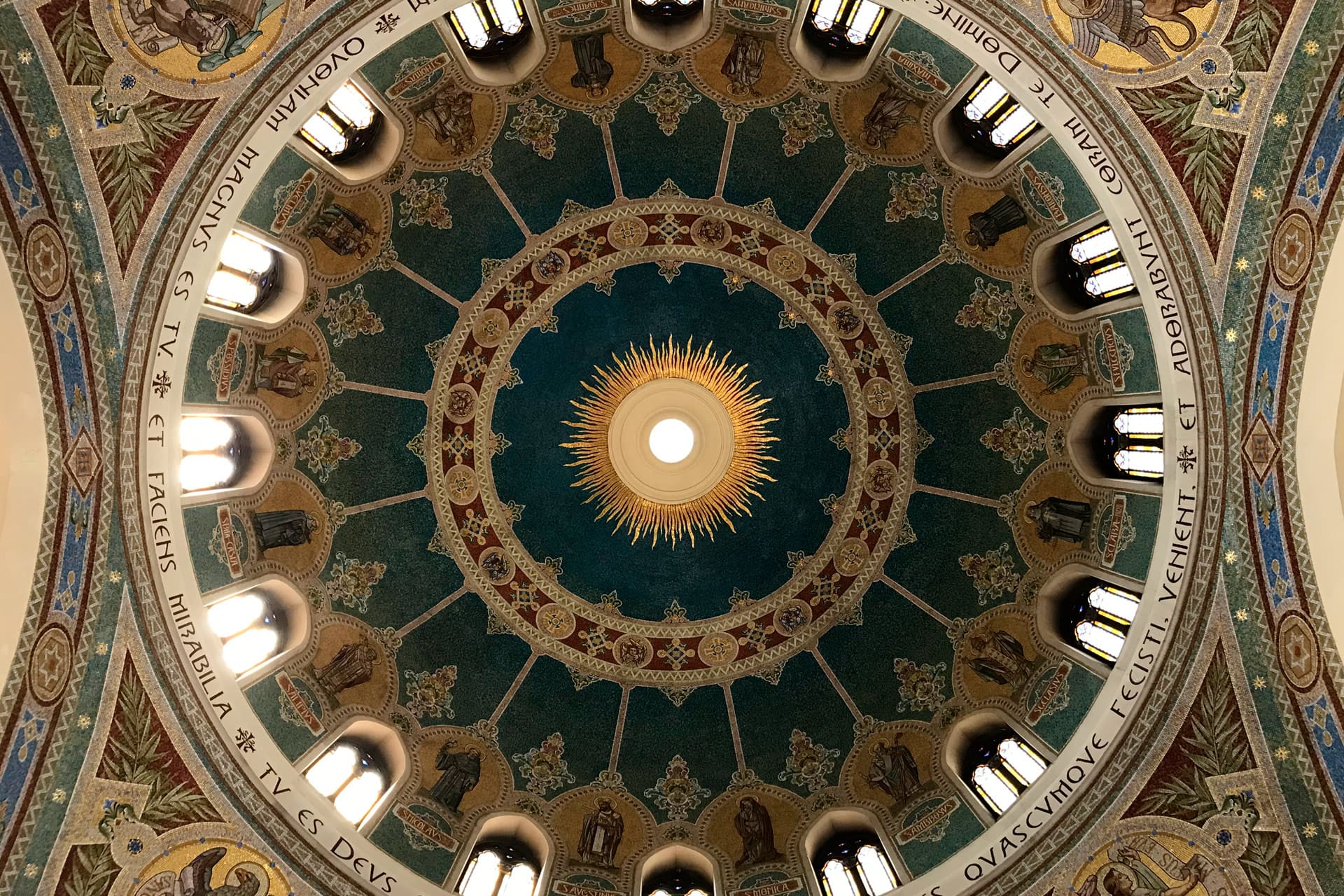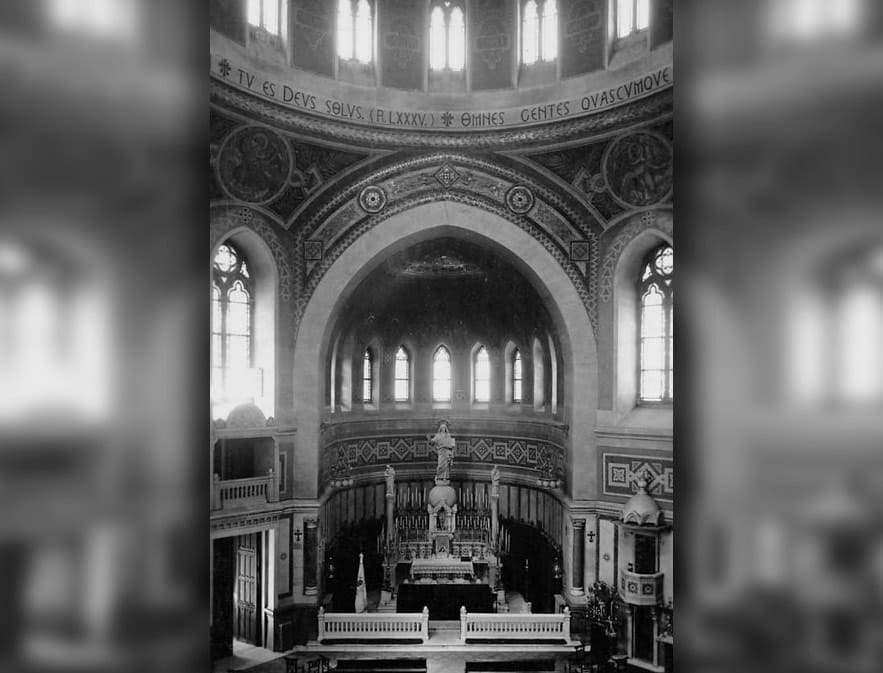Art and faith
Saint Manuel and Saint Benedict
In the heart of Madrid stands the parish church of Saint Manuel and Saint Benedict. It is a temple visited to seek moments of recollection and prayer, both by its parishioners and by countless visitors as they pass through the capital of Spain.
We welcome you to this place that you have arrived at on your visit to Madrid or attracted by its extraordinary architectural originality, because it is the only building in our country erected entirely in neo-Byzantine style.
“Instead, be concerned above everything else with the Kingdom of God and with what he requires of you, and he will provide you with all these other things”
(Saint Matthew 6, 33)
Before entering the temple, we will explain you a little about its short, but intense history. The temple of Saint Manuel and Saint Benedict was built thanks to the deep faith and great devotion of his donors, Mr. Manuel Caviggioli and his wife Mrs. Benita Maurici. It was a couple of humble origins that forged a great fortune during his life. The church took their respective dedications from the names of the donor couple.
The history of this hundred-year-old Madrid temple dates back to the beginning of the last century. At that time, Mrs. Benita, widow, made a commitment with the Augustinian Fathers of the Province of the Philippines to build a church that would house the pantheon for her husband and for her. In addition, she would build a convent for the Augustinian Order and a school dedicated to the free instruction of young workers and to favour their cultural and social promotion. The project would be headed by the “Caviggioli Foundation”.
The first stone of what was initially called Church of the Saviour was laid on May 4, 1903. Fernando Arbós y Tremanti, one of the most important architects of the time, was chosen for the project. The works concluded in 1910 and the temple was consecrated on December 31 of that year by the Augustinian Fray Francisco Javier Valdés, Bishop of Salamanca. The official inauguration took place on the first day of 1911, the feast of Saint Manuel.

“Such is the grace that is freely given, not due to the merits of the one who works, but by the mercy of the one who grants it.”
(Saint Augustine. Letter 140, 19, 48)
In 1936, 25 years later, the Civil War broke out in this blessed place as well. The Augustinian priests were expelled and five religious from the community were murdered. The church was closed to worship to be transformed into a warehouse; the sacristy and attached premises were used as a commissary; while the convent became the headquarters of the Executive Committee of the Communist Party and residence of related militiamen. After the war, the Augustinian community returned to their home, rehabilitating the building. Most of the temple furniture had disappeared, while the cult objects and liturgical ornaments had been looted. Similarly, sadly teaching activity never resumed.
In 1965, in response to the request of the Archdiocese of Madrid, the church became a parish, continuing with the founding line of spiritual accompaniment, care and reception for those most in need. It welcomes not only its parishioners, but also numerous people from Madrid who come daily to proclaim and cultivate their faith, live the Eucharist, celebrate their marriage and other sacraments.
From its foundation to this day, this temple continues to be a spiritual reference point for the people of Madrid, the support of their faith and the sublimation of their joys and sorrows.
After these historical brushstrokes, it is time to access the temple and delve into this place full of beauty and spirituality.
While its exterior architecture stands out for the majesty of the striking white marble in which it is made and for its imposing copper dome; the interior of the temple is solemn and spacious. It has a curious layout, a combination of a central plan and a Latin cross. It has an original octagonal floor plan, as befits a funerary building, because the number eight is associated with infinity and therefore with immortality.
Advance through the central corridor towards the head of the temple and discover its striking interior. If you deem it appropriate, go to the chapels to see them in detail. Behind you, in the choir, there is a magnificent organ from the German Walcker house from 1910 and restored in 1977.
On both sides, there are two chapels. On the right is the funeral chapel of Mr. Manuel Caviggioli and his wife, Mrs. Benita Maurici. The ensemble, made entirely of Carrara marble, is presided over by Saint Benedict, founder of the Benedictine Order and patron of Europe. Above it, rises a stylized column that supports an angel, whose effigy stands out on a fine starry mosaic. On the sides of the altar are the tombs of the donor couple.
On the opposite side, with a pentagonal plan, we see the chapel of Saint Rita. The image of Saint Augustine presides over the complex. Flanking the altar, the carving of Our Lady of Consolation occupies the right niche, while in the left we can see the Virgin of the Way. She is conceived as a Pieta; Maria holds the dead body of her son in her arms. In this chapel, the image of Our Lady of Luján, patron saint of Argentina, was enthroned on October 25, 2000. Here the innumerable Argentine faithful in Madrid have their place to venerate their Mother and patron saint. In the same way, since October 2007, the relics of the Spanish Blessed Augustinian Martyrs of the 20th century can be venerated in this chapel.

“Therefore, if we are children of God, the Spirit of God guides us and the Spirit of God works in us”
(Saint Augustine S. 335 J, 4)
As you have seen, on the walls of the temple there are some simple cross-shaped reliefs corresponding to the fourteen stations of the VIA CRUCIS. On this path we accompany Jesus in his Passion and Death, but we cannot forget that the accompaniment does not end at the tomb. The cross is not a defeat, but the prelude to the definitive triumph over death that will come with the resurrection. VIA LUCIS
We arrived at the head of the temple. Surely since you have entered this sacred enclosure, your attention has been directed to the magnificent dome on the central body of the building. This dome is supported on striking pendentives in which the tetramorphs are represented, symbol of the four evangelists: the eagle of Saint John, the angel of Saint Matthew, the bull of Saint Luke and the lion of Saint Mark. At its base there are sixteen pointed windows through which light penetrates and thus be able to appreciate these magnificent mosaics in all their splendour. Sixteen saints and the blessed related to Saint Augustine and the Augustinian Order are represented in the dome. They are all on a gold background to create the effect of occupying a niche. Beginning with Saint Augustine and his mother Saint Monica at the apex of the pointed arch of the main altar, the figures of Saint Ambrose, Saint Gelasius Pope, Saint Clare of Montefalco, Saint Fulgentius, Saint Alonso de Orozco, Saint Maxima, Saint Simpliciano, Saint John of Sahagún, Saint Thomas of Villanova, Saint Guelmus, Saint Possidius, Saint Rita of Cascia, Saint Alypius and Saint Nicholas de Tolentino, the first saint of the Augustinian Order. The dome is topped with a blazing sun in the centre of which the lantern rises. Meanwhile, on the drum of such an impressive work, a verse from Psalm 86 can be distinguished:
“Omnes gentes quascumque fecisti venient et adorabunt coram te, Domine, et glorificabunt nomen tuum. Quoniam magnus es tu faciens mirabilia. Tu es Deus solus”.
“All the nations that you have created will come and bow down to you; they will praise your greatness. You are mighty and do wonderful things; you alone are God.”

We arrived at the head of the temple. To the right is the pulpit whose canopy is crowned by the «Eagle of Hippo» with outstretched wings. It clearly alludes to Saint Augustine, a teacher of sacred oratory. The apse is semicircular in plan and, as usual in Christian temples, it is oriented towards the east. The sun rises from the east, a symbol of Christ, the true Sun that illuminates us and gives us life.
In the vault, covered with splendid mosaics, we contemplate a Pantocrator. The seated figure of Christ, Lord of the universe, blesses with his right hand and holds the globe of the world in his left hand. He is accompanied by the twelve apostles. The disciples are identified by their traditional iconography and separated by triumphant palm trees with leafy leaves. To the right of the Lord and significantly smaller in size is Saint Peter, the first Pope, with the keys to heaven in his hand. They are accompanied by Saint James the Greater, Saint Philip, Saint Bartholomew, Saint Simon, and Saint James the Less. To the left of Christ is Saint John, the beloved disciple, Saint Andrew, Saint Thomas, Saint Jude Thaddeus, Saint Matthew and finally, Saint Paul, instead of Saint Matthias, who replaced Judas Iscariot.
Then the one who sits on the throne said, “And now I make all things new!” He also said to me, “Write this, because these words are true and can be trusted.”
(Revelation 21, 5)
This impressive Venetian-style mosaic houses the main altar made of fine white Macael marble and inlaid with different chromatic tones. The image of Christ the Saviour presides over the set. On both sides and on columns, are the carvings of Saint Augustine and Saint Joseph. At the bottom of this sculptural complex is the tabernacle where the greatest treasure that we can find in the temple goes unnoticed, the Eucharistic Presence of the Lord. The living Christ has freely saved and redeemed us, he has given us eternal life and is always by our side.
We don’t have much more to tell you. We hope your visit has been pleasant. Before leaving the temple to continue on your way, we invite you to have a moment of recollection and prayer in front of the real presence of the Lord in the tabernacle.
We put at your disposal some prayers that can help you in these moments of internalization. In the same way, thanks to the various links in the text, you can delve into the lives of the saints.

“For God did not send his Son into the world to be its judge, but to be its saviour.”
(Saint John 3, 17)
PRAYER TO CHRIST
Here I am, good and gentle Jesus, kneeling before you. With great fervor I pray and ask you to instill in me genuine convictions of faith, hope and love, with true sorrow for my sins and a firm intention to amend them.
While I contemplate your five wounds with great love and compassion, I remember the words which the prophet David long ago put on your lips: “They have pierced my hands and my feet; I can count all my bones.”
SONNET TO CHRIST CRUCIFIED
I am not moved, my God, to give You love by
thoughts of heaven that You’ve promised me;
nor am I moved by thoughts of dreaded hell
for that alone, to cease offending thee.
I’m moved to see You on the Cross and mocked
with every breath; I’m moved to see Your
body racked with wounds; I’m moved by
Your affronts and by Your death.
I’m moved, in sum, by love for You so great
that I would love You were not heaven there,
and I would fear You, if there were no hell.
You need give me no prize to love You thus,
for even if what I hope I hoped not,
as I now love You I would love You still.
MAKE YOUR DONATION
Help us
- Service and co-responsibility.
- Donations and subscriptions.
